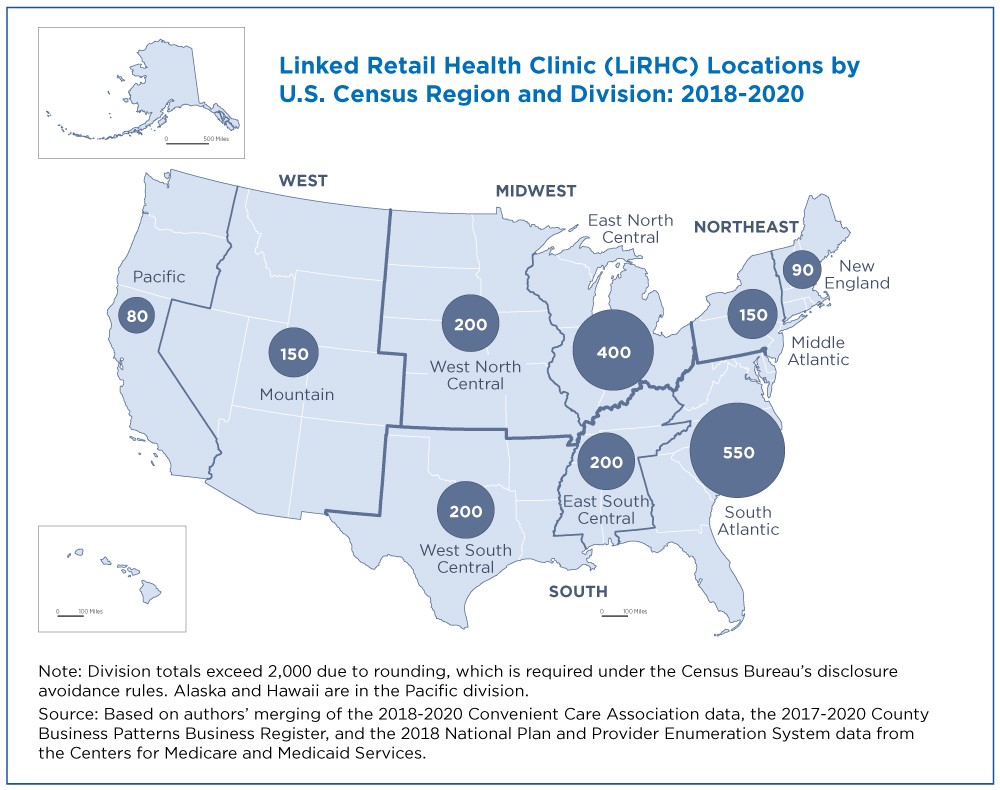Two thousand Retail Health Clinics Provided Walk-In Health Services Mostly in Metropolitan Areas
There were about 2,000 retail health clinics (RHCs) in the United States between 2018 and 2020 that provided convenient health services inside pharmacies, grocery stores and supercenter retailers but most were in metropolitan areas, according to a new database created by the U.S. Census Bureau and the National Center for Health Statistics (NCHS).
Most (950) of these RHCs were in the South region and among divisions, the South Atlantic had the largest number (550).
The Linked Retail Health Clinics (LiRHC) database – part of the Census Bureau’s EHealth Program – is the first step in a multi-phase collaboration to identify RHC locations.
Future phases will examine populations living near retail health clinics, other health care providers located near these clinics, and the business characteristics of retailers that have RHCs.
About 97% of RHCs were in metropolitan statistical areas (which have at least one urbanized area with a population of 50,000 or more) rather than in less densely populated areas.
This new longitudinal LiRHC (pronounced “lyric”) database can help us understand the business characteristics of retailers with RHCs, the socio-economic characteristics of people living near RHCs and other sources of health care such as physicians, urgent care centers and emergency departments near RHCs.
RHCs are in-store clinics that provide health care and treat minor illnesses and injuries. They can be an important source of ambulatory health care across the United States, especially if they are the only available source of health care in an area.
NCHS reports that in 2019, 1 in 4 children and nearly 3 in 10 adults visited an RHC or urgent care center.
About the Research
Data science techniques were used to link external trade association data, Census Bureau business data and a health care provider registry under a new collaboration between the NCHS and the Census Bureau.
Methodology on Creating a Linked Database of U.S. Retail Health Clinics (RHCs) details how the RHC locations were identified.
This new longitudinal LiRHC (pronounced “lyric”) database can help us understand the business characteristics of retailers with RHCs, the socio-economic characteristics of people living near RHCs and other sources of health care such as physicians, urgent care centers and emergency departments near RHCs.
Planned data linkages in the next phase will measure the 2010-2020 availability of RHC locations near households with young children who commonly require convenient heath care services. These unique data linkages will support research on RHC locations in underserved, low income and uninsured communities. LiRHC may also improve understanding of how RHC availability relates to the visits to nearby physicians and hospitals.
NCHS’s National Ambulatory Medical Care Survey (NAMCS) provides national data on visits to physician offices but currently does not collect health care data from RHCs in the United States. This collaboration between NCHS and the Census Bureau may help NAMCS include data from RHCs in the future.
New NCHS and Census Bureau Collaboration
Access to and the cost of health care services are both public health and economic concerns.
Retailers with clinics are of particular interest to the Census Bureau and the National Center for Health Statistics because they given their walk-in settings that provide convenient health care services for minor illnesses and injuries at times physician offices are closed or do not have appointments available.
The cost of an RHC visit, which is generally less than an emergency department visit, may be available before services are provided.
Creating the LiRHC database is the first step in this collaboration focusing on RHCs. The two agencies plan to expand the matching detailed here to identify RHC locations from 2010 to 2017.
This collaboration is motivated by the desire to understand how these clinics impact the population’s health and access to and provision of health care services across the nation.
Subscribe
Our email newsletter is sent out on the day we publish a story. Get an alert directly in your inbox to read, share and blog about our newest stories.
Contact our Public Information Office for media inquiries or interviews.







